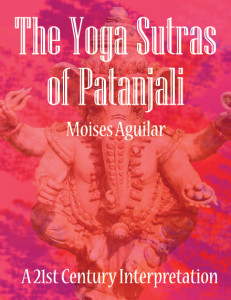 A slam poet of the sutras: Moises Aguilar interprets Patanjali’s Yoga Sutras
A slam poet of the sutras: Moises Aguilar interprets Patanjali’s Yoga Sutras
by Jaclyn Bauer
Moises Aguilar’s “The Yoga Sutras: A 21st century interpretation” (2013) is simultaneously insightful and scandalous. As the subtitle clearly states, the text is not a translation, but an “interpretation” for which Aguilar “armed [him]self with seven different translations.” Aguilar’s “Sutras” aims to be approachable, yet retain the essence of each message conveyed by its original scribe Patanjali.
The reader could imagine Aguilar almost reciting the first group of sutras via slam poetry: “Now let’s talk about yoga. Yoga is attained by removing the noise from the mind so you can remember who you are.” The colloquial diction transforms what has been for years an esoteric and exclusive text into something more inclusive and accessible.
Another innovative aspect of Aguilar’s rendition is his construction of the Sutras “as a continuous text” rather than broken into static glimpses of information as has been the norm. The Yoga Sutras, though never an extant text before Patanjali codified them sometime between 400 B.C.E. and 200 A.D., is believed to have been based on a larger body of knowledge that circulated throughout the culture. The sutras, or aphorisms, then were merely reminders of the larger picture. Similarly, Aguilar is creating that larger picture for our time, filling in the holes he sees with previous interpretations of the text.
Enlightening, relatable and debatable, Aguilar’s interpretation is worth the journey whether you are a strict traditionalist or a light-hearted yogi; there is something for every yogi to take away.
About Moises Aguilar: Moises Aguilar began practicing martial arts at age 7 and took his first meditation course at 10. Since then, Eastern philosophy has been a part of his life. He started practicing yoga in 1999 to help him relax from his traveling consulting job. While helping his wife, Carmen Aguilar, advance her asana practice, he felt especially drawn to the subtleties of adjusting poses. In 2010, Moises and Carmen opened The Lab yoga studio in Chicago. He currently teaches the adjustments and philosophy sections of The Lab’s Teacher Training as well as regular yoga classes. Look for Moises’s next book “Symbols and teachings in the Bhagavad Gita” in mid-2014.























One Response to “BOOK REVIEW: The Yoga Sutras of Patanjali—Moises Aguilar”
August 8, 2014
morry secrestA revealing review, and not incorrect.
I might add that in my own opinion, this is a valuable work on more than one level. Besides being one of the best expositions of the Yoga Sutras of Patanjali that I’ve ever seen, it is also an excellent example of the sort of scholarship needed to truly understand any of the works which have come down to us from the pre-literate era (a term for the time before writing was invented). I speak here of Mr. Aguilera’s process of understanding, as deeply as possible, a given phrase … then, with that new understanding, going back to the beginning and studying all over again each of the sutras.
In my opinion, then, Mr. Aguileras has given us not only a valuable teaching tool (the Yoga Sutras itself) but also a valuable process for understanding other ancient, pre-literate works of literature.